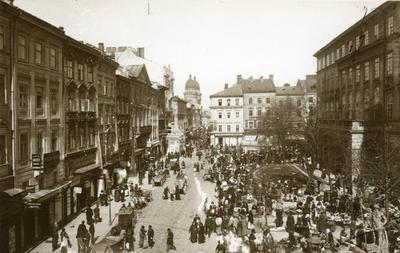Pl. Rynok, 25 – former Yakubsholtsivska/ Jakobszolcowska townhouse
Architecture
The “Jakobszoltsivska” house is located at the western end of the row of structures that surround Market Square. The four-storey, gable-roofed, brick structure sits on a shallow strip foundation over a basement, with an exterior ground floor wall of squared stone block. The original design show the building shaped like an elongated rectangle, a three-story addition – the back hut – in the west end of the courtyard was built later.
The building’s triple-bayed façade is accented by a leonine corbelled balcony on the central bay’s second story. The lobby entrance is located in the left bay, and the right bay opens to the café which occupies the greater part of the ground floor. It was here that the print shop of Ivan Fylypovych was housed during the 18th century. The façade is divided by pilasters and crowned with a wide beveled cornice; second and third storey windows are framed in molded sills and lintels.
The building’s wooden staircase is illuminated with overhead lighting, and features a wrought-iron banister from the second half of the 19th century. Ceiling joists are covered in plaster and lath. Original carved beams have been preserved in the “back hut”, and during a 1930s era restoration of the building a bricked vault was uncovered on the ground floor. The ornamented façade – with elements of baroque and historicism – lends the building its renaissance air.
Personalities
Mikołaj Gelasinus / Śmieszkowicz – scholar, city councilor, building owner
Ivan Fylypovych – shopkeeper,
engraver, printer, member of the Stauropegial monastery brotherhood,
building owner
Jakób Szolc – shopkeeper,
builder, city councilor, building owner
Jan Milikowski – bookseller,
building owner
Edmund Köhler
– architect
Sources
- Scientific-Technical Archive of "Ukrzakhidproektrestavratsia" Institute (UZPR), #L-136-1-11.
- Vuitsyk, Volodymyr. "Rynok Square 25". Selected works from "Ukrzakhidproektrestavratsia" Institute Journal, "On his 70th anniversary", chapter 14. Lviv: "Ukrzakhidproektrestavratsia", 2004. pp128-129.
- Kapral, M. Native Assemblies in Lviv of the 16th-18th centuries (civil and legal interrelations) Lviv: Piramida, 2003.
- Melnyk, B. On the Streets of Old Lviv. Lviv: Svit, 2001.
- Monuments in Urban Construction and Architecture of the Ukrainian Soviet Republic. Volume 3: the Lviv Oblast. Kyiv: Budivelnyk, 1985.
Edited by Ihor Zhuk
Media Archive Materials
Related Pictures













